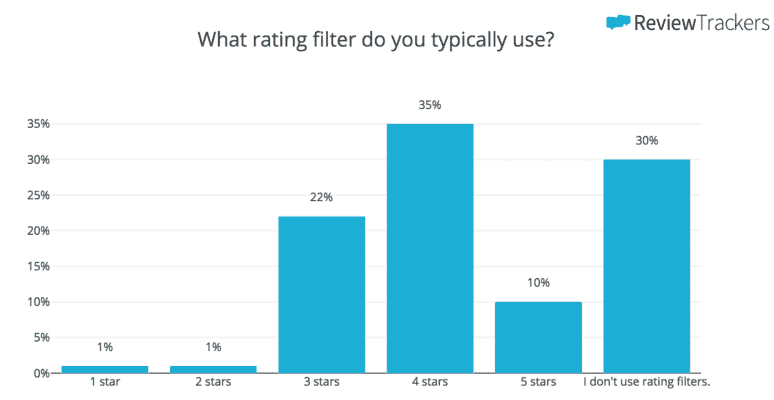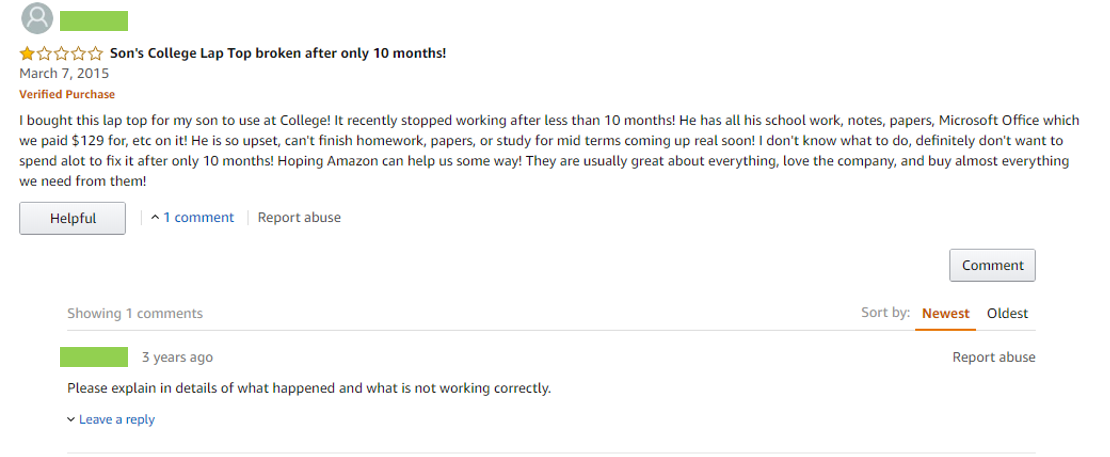Selling on Amazon is much more expensive and difficult to conduct with a poor reputation. Regardless of the nature of the accident that caused the decline in customer trust, they will be more likely to do business with other companies, because they want their experience to be as positive as possible.
In fact, the 2018 ReviewTrackers Online Reviews Survey found that 35% of online shoppers use rating filters and choose to contact businesses with a rating of at least 4 stars.

Clearly, this finding is profound for businesses because if their rating is lower than 4 stars, they could potentially be overlooked by a lot of customers. In fact, the aforementioned survey also found that 80% of customers said they trusted businesses with 4.0, 4.5, and 5 stars.
So, a higher rating proves that your business is worthwhile and reliable, so more people will be willing to contact you. On the other hand, negative reviews are unavoidable, so dealing with them is something that you have to do master.
Why? Because being silent is a pretty good way to trash your reputation. Customers who leave negative reviews expect businesses to respond and offer ways to fix their situation (in fact, 53% of customers expect replies to negative reviews within a week).
Despite that, most businesses leave negative reviews unattended. For example, ReviewTrackers survey also found that 63% of online customers never received a response for their negative reviews, and this means that they never returned to those businesses.
That’s why you should have a good understanding of how to address negative comments from your Amazon customers.
The Main Reasons Why Customers Write Negative Reviews
Before we get to writing responses to negative reviews, let’s talk about the most common reasons why people write them.
Understanding why people write about their negative experiences with brands, products, or services is vitally important to understanding how to respond in the best possible way and even encourage them to change their opinion.
So, here we go.
Reason #1: Negative Reviews Help Other People
That’s nice, right? By sharing their experience with others, customers give a real picture of what they should expect from a business or a product.
What you should do as a business is to respond by acknowledging the problem and asking for more details to address it to improve the experience of future customers.
Reason #2: Product/Service Didn’t Meet a Customer’s Expectations
In this case, the product/service isn’t necessarily bad because the main motivation behind writing a negative review is that they didn’t meet the expectations a customer had before the purchase.
This case requires you to ask for more details and find out why the customers felt this way.
Reason #3: Customers Want to Help Business Improve by providing Feedback
If a customer shows that a certain product or service has a shortcoming or an issue, businesses can use this information and improve them. Here, a business needs to thank the customer for their opinion, and engage with them to get more details on product improvement. This way you can get some valuable information.
Reason #4: Customers Want to be Heard
As we already know, more than 60% of customers who left a negative review didn’t get any response from businesses. That’s frustrating. It’s completely understandable if a person who had a bad experience with a product or service wishes to share it and have their opinions heard and appreciated by both fellow customers and businesses.
The best way to go is to let the frustrated customer know that their voice is heard and engage with them by offering help to make them feel appreciated.
Reason #5: To be a Part of a Crowd
Thousands of people out there leave online reviews because they are a part of a fan group or it’s just something they do to strengthen the feeling of belonging to a certain group of people. In this case, chances are that their reviews will be validated by the members of their group of other who leave reviews often.
Here, asking for more details and offering your assistance to address a problem is the best way to go.
Tips on Writing Response Templates on Amazon
Now that we know why customers leave negative reviews, take a look at four important things to keep in mind to write responses that can help to maintain your reputation (don’t forget to consider Amazon’s official guidelines for posting comments on customer reviews as well).
1. Thank the Reviewer
No matter how nasty the review is, your job is to thank the customer who wrote it. After all, they took some time to provide you with information, and you should appreciate that.
Have a look at this response from a business on Amazon. The person who wrote the reply failed to thank the reviewer for their message, and, to be honest, it doesn’t look like the business representative genuinely wants to help. No surprise that the customer didn’t respond.

2. Respond Promptly
As it was mentioned above, 53% of online shoppers expect businesses to reply to negative comments within a week. By replying within several days or even earlier, you’re demonstrating a commitment to make things right and pay attention to what your customers are saying.
Veronica Wright from Resumes Centre states, “Your potential customers will also see a quick reply and an attempt to address a problem as a good sign, so you’ll minimize the adverse effect on your reputation.”
3. Address the Issue
There’s a specific reason behind every negative review, so it’s your job to not just respond, but identify the issue and fix it. For example, provide your contact data and ask to get in touch for further communication and addressing the problem that the customer had.
This shows that you’re committed to fixing the problem, which is something customers really appreciate.
4. Look Professional
All your replies to reviews should be error-free, otherwise, mistakes can make you look amateur and unprofessional. Be sure to proofread every template you create, and feel free to use online tools such as Grammarly.
5. Identify and Report Fake Reviews
Despite Amazon’s best effort to prevent users from cheating its review system, fake reviews are common. Although the platform claimed that only 1% of all reviews are fake, third-party studies found that up to 61% of reviews in certain categories are falsified.
This, of course, is a huge challenge for honest sellers, so knowing how to spot and report a fake negative review is a must.
Here are the most common signs to look for:
- An unhappy customer writes more than one review for the same product
- A review is written by other sellers
- One-word or one-sentence reviews
- Advertisement or other promotional materials
- Emails addresses, numbers, or web links
- Too many grammar, spelling, and other errors
- Spiteful remarks
- Irrelevant and obscene content.
Amazon encourages sellers to report fake reviews, so monitor your reviews constantly and let them know if you think it’s falsified.
Final Thoughts
If you follow the above tips and practice excellent customer service, chances are that some of the negative reviews will disappear. For example, customers may change their view of your company after having you fixing the problem. So, view negative reviews are a challenge to your reputation that should be dealt with urgently and try to communicate with every customer who felt dissatisfied with your service.
And remember: every seller has to deal with a fair share of negative reviews, but your effort still plays a deciding role on how well your product or service is rated.



